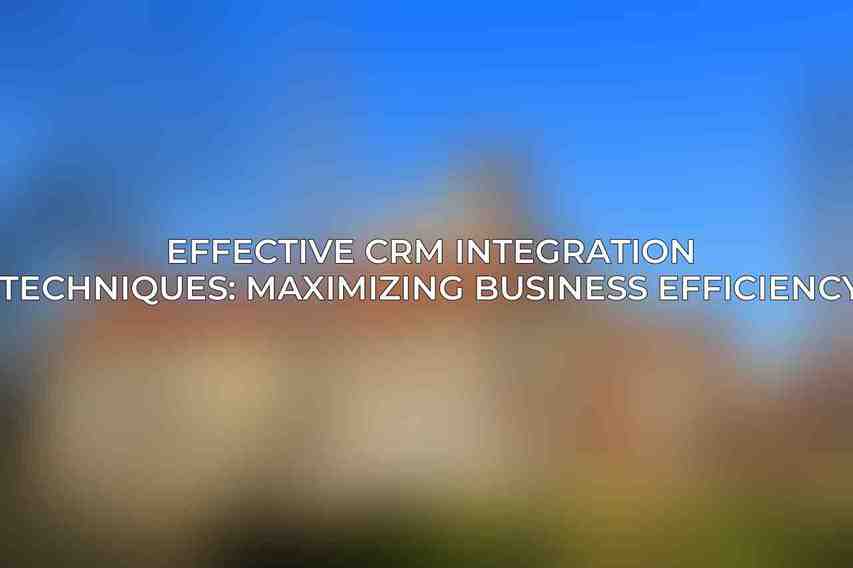CRM integration involves the process of connecting customer relationship management (CRM) systems with other business systems to streamline operations and enhance customer service. The integration of CRM systems can bring about various benefits such as improved customer service, streamlined workflows, and increased data accuracy. However, challenges such as data security, data quality, and system compatibility need to be addressed for successful integration.
Planning and Preparation
To effectively integrate CRM systems, thorough planning and preparation are essential. This involves establishing a clear business case by defining goals, objectives, and expected benefits. Conducting a comprehensive assessment of existing systems and data is crucial to identify integration points accurately. Prioritizing the systems to be integrated and developing a detailed integration plan are key steps to ensure a smooth integration process.
Integration Techniques

Direct Integration
Direct integration involves using Application Programming Interfaces (APIs) or web services to establish a direct connection between systems. This method offers fast, secure, and reliable data exchange. However, it requires technical expertise and may involve custom coding to ensure seamless integration.
Indirect Integration
Indirect integration utilizes middleware or Extract, Transform, Load (ETL) tools to facilitate data exchange between systems. While this method requires less technical expertise and can handle complex data transformations, it may introduce latency and performance overhead.
Data Synchronization
Data synchronization involves using scheduled tasks or triggers to keep data consistent across integrated systems. This technique is relatively simple to implement and can manage large volumes of data efficiently. However, manual intervention may be required to resolve conflicts that arise during synchronization.
Cloud-Based Integration
Cloud-based integration leverages cloud services to connect systems, offering scalability, cost-effectiveness, and ease of management. Despite these benefits, security concerns and dependency on third-party providers are factors that need to be considered when opting for cloud-based integration.
Data Management

Effective data management is vital for successful CRM integration. This includes ensuring data quality by maintaining accuracy, consistency, and completeness. Establishing data mapping rules, conducting data cleansing to remove duplicates and inconsistencies, and implementing data governance policies are essential for efficient data management. Read more on Small Business CRM Selection: Choosing the Right Fit
Security and Compliance
Security and compliance aspects play a crucial role in CRM integration. Implementing access controls to protect sensitive data, ensuring compliance with privacy regulations, establishing disaster recovery and backup plans, and conducting regular security audits are necessary measures to safeguard integrated systems.
Monitoring and Evaluation
Continuous monitoring and evaluation are necessary to ensure the effectiveness of CRM integration techniques. Establishing key performance indicators (KPIs), monitoring system performance and data quality, obtaining feedback from users, and making necessary adjustments based on feedback are vital for optimizing the integration process.
Best Practices
Implementing the following best practices can enhance the success of CRM integration:
– Phased approach: Adopt a phased approach to integration to minimize disruption.
– Stakeholder involvement: Involve key stakeholders throughout the integration process to ensure alignment with business objectives.
– Experienced vendor: Engage a vendor with expertise in CRM integration to provide guidance and support.
– Thorough testing: Conduct thorough testing and documentation of the integration to identify and resolve issues.
– Continuous monitoring: Continuously monitor and evaluate the integration to make improvements and adjustments as needed.
effective CRM integration techniques are essential for maximizing business efficiency. By following the outlined strategies for planning, preparation, integration, data management, security, monitoring, and best practices, organizations can achieve improved customer engagement, increased revenue, and operational efficiency through successful CRM integration. Emphasizing the significance of ongoing monitoring and evaluation can lead to continuous enhancement and optimization of integrated systems. Read more on CRM Analytics: Unlocking Customer Insights for Growth
Frequently Asked Questions
What is CRM integration and why is it important?
CRM integration is the process of connecting a Customer Relationship Management system with other software applications to streamline and automate business processes. It is important because it allows for a centralized view of customer data, improves data accuracy, and enhances communication between departments.
How can CRM integration help maximize business efficiency?
CRM integration helps maximize business efficiency by enabling seamless data sharing between different departments, reducing manual data entry, automating repetitive tasks, providing real-time insights, and enhancing customer service.
What are some common challenges faced during CRM integration?
Some common challenges during CRM integration include data migration issues, lack of system compatibility, resistance from employees to adopt new technology, poor planning, and insufficient training.
What are some effective CRM integration techniques to enhance business efficiency?
Effective CRM integration techniques include defining clear objectives, selecting the right CRM system, ensuring data quality, customizing the CRM system to fit the organization’s needs, providing thorough training to employees, and continuously monitoring and optimizing the integration process.
How can businesses measure the success of CRM integration in maximizing efficiency?
Businesses can measure the success of CRM integration in maximizing efficiency by tracking key performance indicators (KPIs) such as customer satisfaction, lead conversion rates, sales revenue, productivity improvements, and return on investment (ROI) from the integration.

